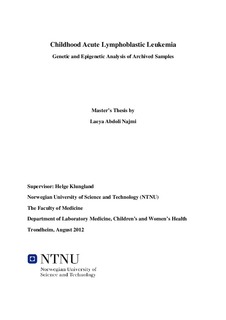| dc.contributor.advisor | Klungland, Helge | nb_NO |
| dc.contributor.author | Najmi, Laeya Abdoli | nb_NO |
| dc.date.accessioned | 2014-12-19T14:19:45Z | |
| dc.date.available | 2014-12-19T14:19:45Z | |
| dc.date.created | 2012-12-03 | nb_NO |
| dc.date.issued | 2012 | nb_NO |
| dc.identifier | 573713 | nb_NO |
| dc.identifier.uri | http://hdl.handle.net/11250/263885 | |
| dc.description.abstract | Acute lymphoblastic leukemia (ALL) is recognized as a fast-developing cancer originated from blood-progenitor cells. Blasts cells are immature cells which generate white blood cells (leukocytes), and it is the malignancy of the blast cells which lead to leukemias. The bone marrow is gradually filled up with these blasts and as a result, the production of healthy blood cells will be damaged. Malignant cells might also find their way to the blood circulation and have the ability to infiltrate vital organs as the brain and spinal cord. As the number of healthy bone marrow cells decrease, the development of severe organ failure will take place, and it will turn into a lethal disease.
Great advances in leukemia treatment have resulted in high cure rates of more than 80% in children. However, treatment related death for this disease is still 2-4%. For further treatment improvement, it is required to customize treatment for each individual patient. The interindividual differences in response to treatment and its toxicity are caused by many factors in which genetic variations including single-nucleotide polymorphisms (SNPs) seems to play an important role. The development of genome-based treatment is possible by making associations between an individual genetic make-up and the drug response. The uses of archived samples increase the feasibility of the retrospective study. In the present study, archived samples from patients who died because of treatment toxicity were used for multiple SNPs analysis and DNA methylation study.
DNA was extracted from smears and formalin fixed paraffin embedded bone marrow tissues. The quantity of isolated DNA was measured by UV spectroscopy and Fluorometric methods, and the quality of the isolated DNA was assayed by evaluation of the ability of samples that were amplified using DNA profile analysis. Generally, smears were able to amplify markers up to 234 bp and FFPE tissues up to 170 bp. In this study, multiple SNPs analysis failed in most of the samples with highly degraded DNA. Based on the findings, the average SNPs call rate was 91% for reference blood samples and 74% for smears with 4x sequencing depth.
In a parallel study, DNA methylation of IL-8 was analysed by methylation-specific PCR using archived samples. In this methylation analysis, all samples were amplified successfully to an amplicon size of 173bp. We detected IL-8 hypomethylation in 98% of bone marrow smears and in 96% of FFPE bone marrow tissues in patient with acute lymphoblastic leukemia. | nb_NO |
| dc.language | eng | nb_NO |
| dc.publisher | Norges teknisk-naturvitenskapelige universitet, Det medisinske fakultet, Institutt for laboratoriemedisin, barne- og kvinnesykdommer | nb_NO |
| dc.title | Childhood Acute Lymphoblastic Leukemia: Genetic and Epigenetic Analysis of Archived Samples | nb_NO |
| dc.type | Master thesis | nb_NO |
| dc.source.pagenumber | 80 | nb_NO |
| dc.contributor.department | Norges teknisk-naturvitenskapelige universitet, Det medisinske fakultet, Institutt for laboratoriemedisin, barne- og kvinnesykdommer | nb_NO |
